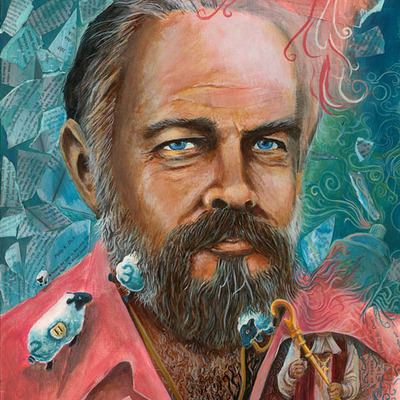Editors note: Thanks to everyone who showed interest in doing a reread series on Reality Sandwich. For those of you who are new to the concept: a reread is where we pick a book, read a chapter or two a week, blog about it and discuss it. Sometimes passionately. Take a look at Tor.com for good examples.
It’s all about community and coming together for the literature we love. The catch is, this is R.S., so we won’t exactly be doing your ordinary rereading. Hence our first pick: VALIS! New readers are welcome. If you have suggestions for the next book, email me: jeremy (at) evolver (dot) net.
“I think that, like in my writing, reality is always a soap bubble, Silly Putty thing anyway. In the universe people are in, people put their hands through the walls, and it turns out they’re living in another century entirely. … I often have the feeling — and it does show up in my books — that this is all just a stage.” — Philip K. Dick
Every constellation of so-called “counter-culture” is woven by assemblages of meaning. Syntax. Context. Literature cobbles together culture, and culture cobbles together a “moment” in time that has a particular flavor. Some of these post-modern assemblages live on over the decades and get retrieved by new generations of readers, doing with it what they will. Some books, you might say, are woven into the D.N.A of a particular historical moment. Or, perhaps if they’re not recognized in their own time, are come to be seen as occluded masterpieces that foreshadowed the possible. Philip K. Dick is by far one of the greatest science fiction writers of the 20th century. His writing hits home in our postmodern world of quicksand realities, where nothing is real and everything could very well be a fake. Virtuality. Holograms. Altered states of consciousness. Building worlds that don’t fall apart two days later. These are some of Dick’s concerns. But, as we’ll see, and as a number of authors have pointed out, Dick’s writing edges into the supernatural and the paranormal in its quest to seek to the “authentic” experience. Out from the “black-iron prison” of fake realities, the constructs of political power, and media manipulation.
Philip K. Dick was the author of books like VALIS, UBIK, Man in the High Castle, A Scanner Darkly, and Do Androids Dream of Electric Sheep? Maybe we can reread through them all sometime (for many of you, like myself, it will be the first time).
The reason I came to choose VALIS, beyond popular vote, was how quintessential a book it really is. Part auto-biography, part fiction, VALIS was an attempt on Dick’s part to write himself through a period of intense religious experiences, and as Richard Doyle suggests here, that’s exactly what he did: “hack” the hero’s journey and write himself anew.
You didn’t think this would be a normal reread series, did you? Good. Because we’re jumping right into the weird.
VALIS
“The basic tool for the manipulation of reality is the manipulation of words.” — PKD
Jeffrey Kripal, author of Mutants and Mystics and Authors of the Impossible, suggests that writing (and by extension, reading) are more than just words on the page. In a slippage between the meal-times of the Black Iron Prison, we sometimes, inadvertently, gain the ability to author our own existences.”The mental dimension and the material dimension begin to resonate or correspond to one another in very dramatic, and very detailed ways” (1). World becomes word, and sitting at the keyboard, we start to wield influence over the seemingly random and happenstance events in our lives. The keys to escape the prison are in hand.
VALIS, however, is not just about escaping hyper-real post-modern prisons. It’s also about what he called the “in-breaking of God.” In February of 1974, Dick had a series of intense, religious experiences involving what he called a “pink light” that, he claims, beamed spiritual information directly into his mind.
It all began after having his wisdom tooth removed, waiting for his medication (Darvon) to be delivered to his door. The woman at the door was wearing a golden fish pendant, the kind we are all-too-familiar with now adorning the bumper stickers of cars all across the American mid-west. But for Dick, this was no ordinary meeting. “The golden fish causes you to remember,” he writes in his journal, “remember what? Your celestial origins… the Gnostic Gnosis: you are here in this world in a thrown condition; but are not of this world” (2).
A series of visionary experiences — or hallucinations, Dick went back and forth on this — began to happen where Dick was transported out of his time and into ancient Rome (more on that as we begin to read chapter 2). The name, V.A.L.I.S. stands for a “Vast, Active, Living Intelligence System,” that was the pink light he had experienced beaming into his head. In one occasion, Dick was zapped with the knowledge that his young son, Christopher, was suffering from an un-diagonised inguinal hernia. This turned out to be true.
Like many writers do, Dick attempted to channel these half-visionary, half-maddening experiences into his art. And, like many writers say including myself, it was art that helped to metabolize experiences that were impossible to explain rationally.
Dick hasn’t been the first, or the last, person to blur the edges of reality and fantasy, or writing and the paranormal. His writing has gone on not only to influence decades of science fiction writers, but also comic-book writers, neo gnostic practitioners and magicians alike (the comic-book writer and artist, Grant Morrison, arguably was deeply influenced by the whole gnostic “Black Iron Prison” idea in his The Invisibles, and went through a rather traumatic experience of developing the same life-threatening illness his character, King Mob, had in one of the issues).
So a word of warning to the reader: P.K.D’s writings may be capable of what professor Richard Doyle calls the “involution” effect (bold font is added by me):
“After a sufficient dosage of PKD’s work… [readers] are likely to experience an “involution” – a re-orientation of consciousness away from matter and toward the apparently internal domain suffused by consciousness. Dick sometimes named this experience “VALIS.”
A few of my friends participating in this ReRead have already told me they experienced odd dreams after reading chapter one. So, don’t say we didn’t warn you.
Reading Schedule: Chapters 1 & 2 this week — if you haven’t already! I’ll be posting a re-read of these chapters in the next day or two. If you don’t have enough time to read, don’t feel bad following along through the reread updates.
Primer Notes and Additional (Re)reads:
1. Authors of the Impossible, a TEDx Talk by Dr. Jeffrey Kripal
2. “Philip K. Dick’s Divine Interference” by Erik Davis.
3. Professor Richard Doyle has been doing a phenomenal online class, “Radio Free VALIS” on everything I talked about here and more. Highly recommend you check it out over at Synchcast.
4. If you do happen to have an unusual experience or insight accompanying your reading of VALIS, why not share it with us? Use the comments section here, or email me: jeremy (at) evolver (dot) net. I’d be interested to see what takes place over the coming weeks in our collective reading circle.
5. Artwork featured in this blog with permission from the artists. The first image, “A Philip K. Dick Moment” is by artist Robert Jimenez. Check out his artwork at zerostreet.com. Second image of VALIS cover-art by Jacob Stead. Thanks guys!
6. VALIS suggested soundtrack: The Light by Cujo.
Thank you so much for participating with me, and happy re-reading!
















